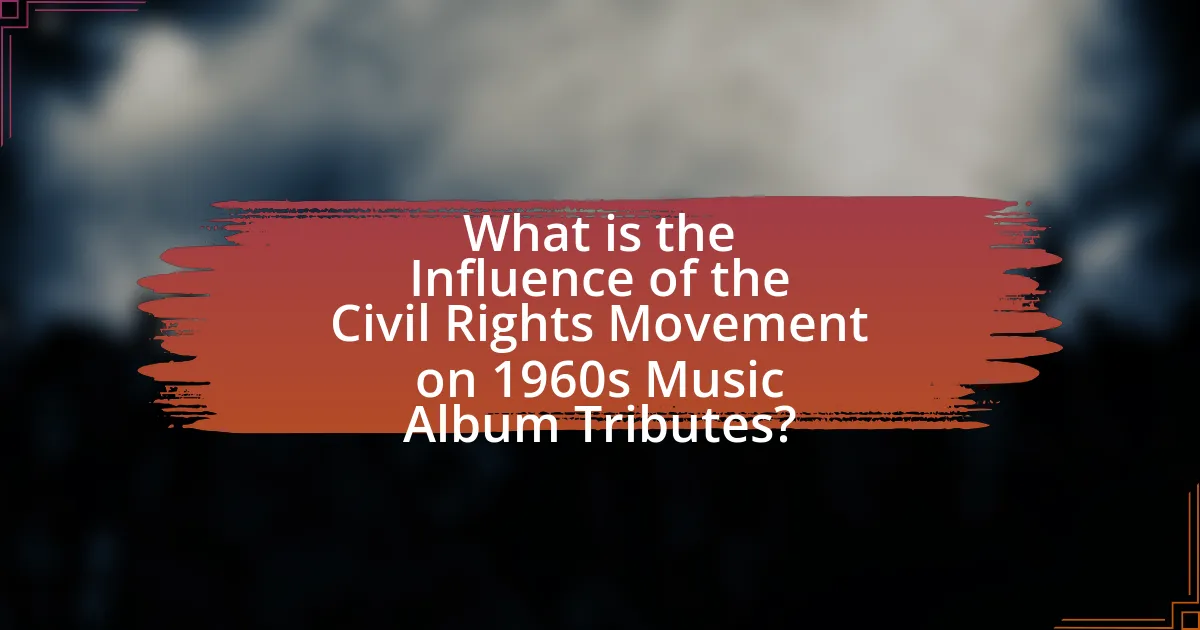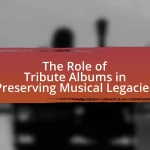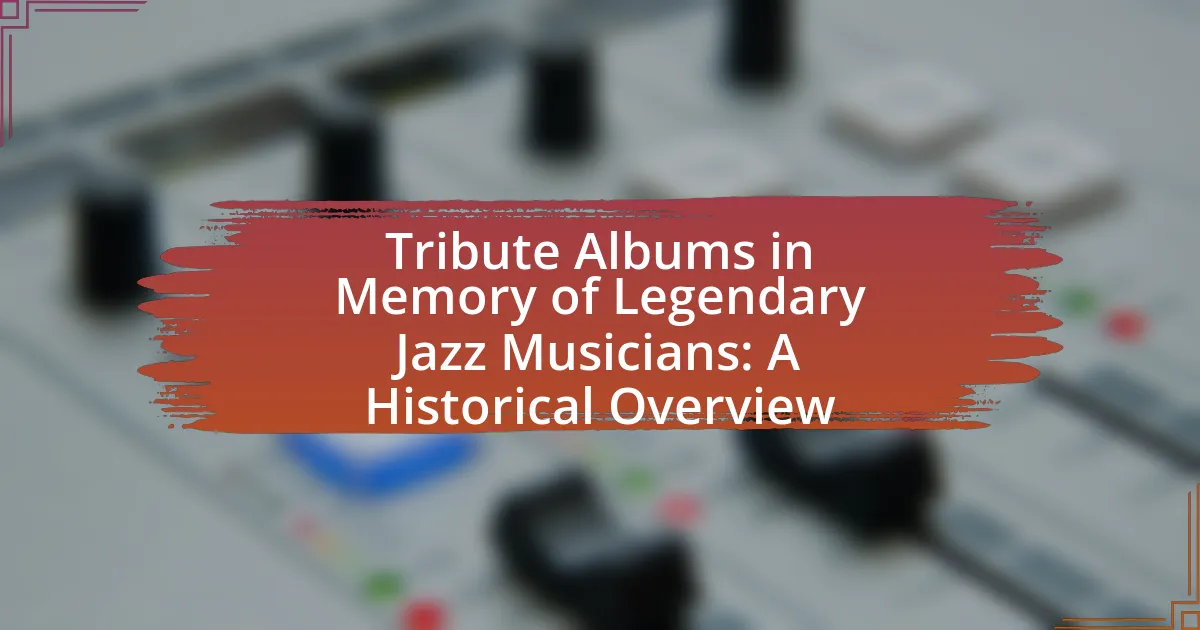The article examines the profound influence of the Civil Rights Movement on music album tributes in the 1960s, highlighting how artists like Nina Simone and Sam Cooke addressed themes of social justice and racial equality through their work. Key events such as the Montgomery Bus Boycott and the March on Washington inspired musicians to create anthems that galvanized public support for civil rights issues. The article also discusses notable albums that paid tribute to the movement, the prevalent themes within these works, and the lasting impact they have had on contemporary music and social activism. Through this exploration, the article underscores the vital role music played in both reflecting and shaping the cultural landscape of the era.

What is the Influence of the Civil Rights Movement on 1960s Music Album Tributes?
The Civil Rights Movement significantly influenced 1960s music album tributes by inspiring artists to address social justice themes and racial equality in their work. Musicians like Nina Simone and Sam Cooke created powerful songs that reflected the struggles and aspirations of the movement, such as Simone’s “Mississippi Goddam” and Cooke’s “A Change Is Gonna Come.” These tributes not only served as a form of artistic expression but also galvanized public awareness and support for civil rights issues, demonstrating the profound connection between music and social activism during this era.
How did the Civil Rights Movement shape the music of the 1960s?
The Civil Rights Movement significantly shaped the music of the 1960s by inspiring artists to create songs that addressed social justice, equality, and civil rights issues. Prominent musicians like Bob Dylan and Nina Simone used their platforms to highlight the struggles faced by African Americans, with Dylan’s “The Times They Are a-Changin'” and Simone’s “Mississippi Goddam” serving as anthems for the movement. These songs not only reflected the sentiments of the time but also galvanized public support for civil rights initiatives, demonstrating the powerful intersection of music and social change during this pivotal decade.
What key events in the Civil Rights Movement influenced musical expression?
Key events in the Civil Rights Movement that influenced musical expression include the Montgomery Bus Boycott, the March on Washington, and the Selma to Montgomery marches. The Montgomery Bus Boycott in 1955, sparked by Rosa Parks’ refusal to give up her bus seat, led to the emergence of protest songs that highlighted racial injustice. The March on Washington in 1963, where Martin Luther King Jr. delivered his “I Have a Dream” speech, inspired artists like Sam Cooke to create anthems such as “A Change Is Gonna Come,” reflecting the hope for equality. The Selma to Montgomery marches in 1965 galvanized musicians like Nina Simone, who used her platform to address civil rights issues in songs like “Mississippi Goddam.” These events collectively shaped the musical landscape of the 1960s, intertwining activism with artistic expression.
How did artists respond to the social changes during this period?
Artists responded to the social changes during the Civil Rights Movement by creating music that addressed racial injustice and promoted social equality. Prominent musicians like Bob Dylan and Nina Simone used their platforms to highlight the struggles faced by African Americans, with songs such as “The Times They Are a-Changin'” and “Mississippi Goddam” serving as anthems for the movement. These works not only reflected the sentiments of the time but also galvanized public opinion and inspired activism, demonstrating the powerful role of music in social change.
What role did music play in the Civil Rights Movement?
Music served as a powerful tool for expression and mobilization during the Civil Rights Movement. It provided a means for activists to communicate their struggles, unify participants, and inspire action. Songs like “We Shall Overcome” became anthems of the movement, symbolizing hope and resilience, while artists such as Nina Simone and Sam Cooke used their platforms to address racial injustice directly in their lyrics. The incorporation of spirituals, folk songs, and newly composed protest songs fostered a sense of community and solidarity among activists, reinforcing their message and energizing demonstrations. The impact of music was evident in its ability to transcend barriers, reaching diverse audiences and amplifying the movement’s goals, as seen in events like the March on Washington in 1963, where music played a central role in the proceedings.
Which songs became anthems for the movement and why?
Songs that became anthems for the Civil Rights Movement include “We Shall Overcome,” “A Change Is Gonna Come,” and “Fight the Power.” “We Shall Overcome” emerged as a unifying hymn for activists, symbolizing hope and resilience in the face of oppression. “A Change Is Gonna Come,” written by Sam Cooke, articulated the struggles and aspirations of African Americans, resonating deeply with the movement’s goals for equality and justice. “Fight the Power,” by Public Enemy, served as a rallying cry against systemic racism and injustice, emphasizing the need for empowerment and resistance. These songs encapsulated the emotions, struggles, and aspirations of the movement, making them powerful anthems that inspired activism and solidarity.
How did music serve as a tool for activism during this time?
Music served as a powerful tool for activism during the Civil Rights Movement by conveying messages of resistance, unity, and social justice. Artists like Bob Dylan and Nina Simone used their songs to highlight racial injustices and inspire collective action, with tracks such as “The Times They Are a-Changin'” and “Mississippi Goddam” directly addressing the struggles faced by African Americans. These songs became anthems for protests and rallies, galvanizing support and raising awareness about civil rights issues. The incorporation of music into activism not only provided emotional resonance but also fostered a sense of community among activists, making it an essential element of the movement’s strategy for change.

What are the notable 1960s music albums that paid tribute to the Civil Rights Movement?
Notable 1960s music albums that paid tribute to the Civil Rights Movement include “We Shall Overcome” by Pete Seeger, released in 1963, which features songs associated with the movement and emphasizes themes of hope and resilience. Another significant album is “Songs of Protest, War, and Peace” by various artists, released in 1965, which includes tracks that address social justice and civil rights issues. Additionally, Nina Simone’s “Nina Simone in Concert,” released in 1964, contains the powerful song “Mississippi Goddam,” directly addressing racial injustice and violence. These albums reflect the cultural and political climate of the era, highlighting the intersection of music and activism during the Civil Rights Movement.
Which artists created tributes to the Civil Rights Movement in their albums?
Artists such as Nina Simone, Sam Cooke, and Stevie Wonder created tributes to the Civil Rights Movement in their albums. Nina Simone’s album “Protest Songs” includes powerful tracks like “Mississippi Goddam,” which directly addresses racial injustice. Sam Cooke’s “A Change Is Gonna Come” became an anthem for the movement, reflecting the struggles and hopes of African Americans during that era. Stevie Wonder’s “Songs in the Key of Life” features themes of social justice and equality, showcasing his commitment to the cause. These artists used their music to amplify the messages of the Civil Rights Movement, making significant contributions to its legacy.
What themes were prevalent in these tribute albums?
The prevalent themes in tribute albums from the 1960s, influenced by the Civil Rights Movement, include social justice, empowerment, and unity. These albums often featured songs that addressed racial inequality, celebrated African American culture, and called for change, reflecting the urgent societal issues of the time. For instance, artists like Nina Simone and Sam Cooke used their music to highlight the struggles faced by African Americans, with songs such as “Mississippi Goddam” and “A Change Is Gonna Come” becoming anthems for the movement. The incorporation of these themes not only resonated with the experiences of the listeners but also served to galvanize support for civil rights initiatives, demonstrating the powerful intersection of music and activism during this pivotal era.
How did these albums reflect the struggles and achievements of the movement?
The albums from the 1960s reflect the struggles and achievements of the Civil Rights Movement by addressing themes of racial injustice, empowerment, and social change. For instance, songs like “A Change Is Gonna Come” by Sam Cooke encapsulate the pain of discrimination while simultaneously expressing hope for a better future, directly linking the music to the emotional landscape of the movement. Additionally, artists such as Nina Simone used their platforms to highlight the harsh realities of racism and advocate for equality, as seen in her song “Mississippi Goddam.” These works not only served as anthems for protests but also documented the collective experiences of African Americans during this pivotal time, illustrating both the challenges faced and the progress made in the fight for civil rights.
What impact did these tribute albums have on society and culture?
Tribute albums from the 1960s, particularly those influenced by the Civil Rights Movement, significantly impacted society and culture by raising awareness of social justice issues and fostering a sense of community among marginalized groups. These albums often featured songs that addressed themes of equality, resistance, and empowerment, which resonated deeply with listeners during a time of profound social upheaval. For instance, albums like “We Shall Overcome” not only celebrated the struggle for civil rights but also became anthems for activism, galvanizing support and solidarity among diverse audiences. The cultural significance of these tribute albums is evidenced by their role in popularizing protest music, which became a vital tool for political expression and mobilization during the era.
How did listeners respond to these albums during the 1960s?
Listeners responded to albums influenced by the Civil Rights Movement in the 1960s with significant enthusiasm and engagement. Many albums, such as “What’s Going On” by Marvin Gaye and “Songs in the Key of Life” by Stevie Wonder, resonated deeply with audiences, reflecting the social and political climate of the time. The emotional and poignant themes of these albums sparked conversations about race, equality, and justice, leading to increased sales and chart success. For instance, “What’s Going On” topped the Billboard charts and became a cultural touchstone, illustrating how listeners embraced music that addressed their struggles and aspirations during the Civil Rights Movement.
What legacy did these albums leave for future generations?
The albums influenced by the Civil Rights Movement left a legacy of social awareness and activism for future generations. These works, such as “What’s Going On” by Marvin Gaye and “Songs in the Key of Life” by Stevie Wonder, addressed issues of racial injustice, inequality, and human rights, inspiring subsequent artists to use their platforms for social change. The impact is evident in the continued relevance of their themes, as modern musicians often cite these albums as foundational influences in their own advocacy for social justice, demonstrating the enduring power of music as a catalyst for change.

How can we analyze the lasting effects of the Civil Rights Movement on music today?
The lasting effects of the Civil Rights Movement on music today can be analyzed through the examination of lyrical content, genre evolution, and the incorporation of social justice themes in contemporary music. Artists such as Kendrick Lamar and Beyoncé explicitly reference civil rights issues in their work, reflecting the movement’s enduring influence. For instance, Kendrick Lamar’s album “To Pimp a Butterfly” addresses systemic racism and inequality, echoing the themes of protest music from the 1960s. Additionally, genres like hip-hop and R&B have roots in the civil rights struggle, showcasing how the movement shaped musical expression and continues to inspire new generations of artists. This analysis reveals a direct lineage from the civil rights era to modern music, highlighting the movement’s profound impact on cultural and artistic landscapes.
What contemporary artists draw inspiration from 1960s Civil Rights music?
Contemporary artists such as Common, Janelle Monáe, and Kendrick Lamar draw inspiration from 1960s Civil Rights music. Common incorporates themes of social justice and activism in his lyrics, reflecting the spirit of the Civil Rights Movement. Janelle Monáe’s work often addresses issues of race and identity, echoing the messages found in 1960s protest songs. Kendrick Lamar’s music, particularly in albums like “To Pimp a Butterfly,” directly references the struggles and triumphs of the Civil Rights era, showcasing a deep connection to the historical context of that music.
How do modern tributes compare to those from the 1960s?
Modern tributes differ from those of the 1960s primarily in their scope and representation of diverse voices. While 1960s tributes often focused on prominent figures within the Civil Rights Movement, such as Martin Luther King Jr. and Malcolm X, modern tributes encompass a broader range of social issues and include a wider array of artists from various backgrounds. For instance, contemporary tributes frequently address intersectionality, incorporating themes related to gender, sexuality, and global movements, reflecting a more inclusive approach. This evolution is evident in the music industry, where artists like Beyoncé and Kendrick Lamar use their platforms to honor historical figures while also addressing current social injustices, thus expanding the narrative beyond the confines of the 1960s.
What messages are conveyed in today’s music that echo the Civil Rights Movement?
Today’s music conveys messages of social justice, equality, and resistance that echo the Civil Rights Movement. Artists frequently address systemic racism, police brutality, and the fight for civil rights, mirroring the themes prevalent during the 1960s. For example, songs like “This Is America” by Childish Gambino highlight issues of gun violence and racial inequality, while “Alright” by Kendrick Lamar serves as an anthem of hope and resilience in the face of oppression. These contemporary messages resonate with the historical struggles for civil rights, emphasizing the ongoing fight against discrimination and the demand for justice.
What lessons can we learn from the intersection of music and social justice?
The intersection of music and social justice teaches us that music can be a powerful tool for activism and societal change. Historical examples, such as the songs of the Civil Rights Movement in the 1960s, illustrate how artists like Bob Dylan and Nina Simone used their platforms to address racial inequality and inspire collective action. Songs like “The Times They Are a-Changin'” and “Mississippi Goddam” not only reflected the struggles of the time but also galvanized listeners to engage in social justice efforts. This demonstrates that music can amplify marginalized voices and foster community solidarity, making it an essential element in the pursuit of social justice.
How can music continue to be a vehicle for change in society?
Music can continue to be a vehicle for change in society by serving as a powerful medium for social commentary and mobilization. Throughout history, music has played a crucial role in movements for civil rights, as seen in the 1960s when artists like Bob Dylan and Nina Simone used their songs to address issues of racial injustice and inequality. For example, Dylan’s “The Times They Are a-Changin'” became an anthem for social change, reflecting the sentiments of a generation demanding equality. This historical precedent demonstrates that music can inspire collective action and raise awareness about pressing social issues, making it an enduring tool for advocacy and transformation in society.
What best practices can artists adopt to honor the legacy of the Civil Rights Movement?
Artists can honor the legacy of the Civil Rights Movement by creating works that reflect its themes of justice, equality, and social change. This can be achieved through the incorporation of historical narratives and personal stories that highlight the struggles and achievements of civil rights activists. For instance, artists can use their platforms to raise awareness about ongoing social issues, similar to how musicians like Nina Simone and Sam Cooke addressed civil rights in their songs during the 1960s. Additionally, collaborating with community organizations and participating in social justice initiatives can further amplify their message and connect their art to contemporary movements. By engaging in educational outreach and using art as a tool for activism, artists can effectively honor the legacy of the Civil Rights Movement while inspiring future generations.




